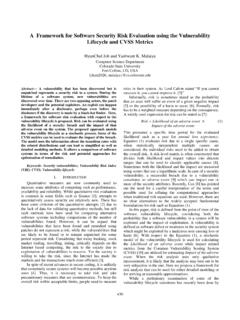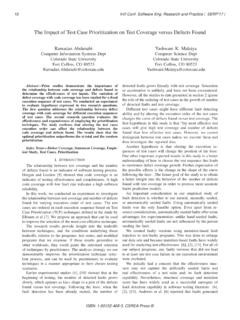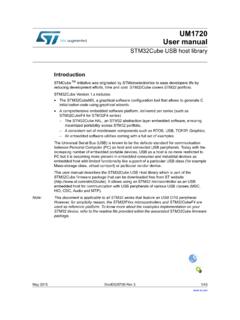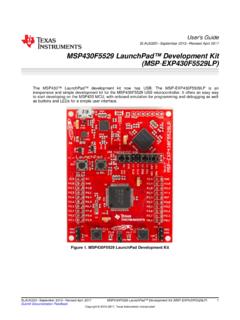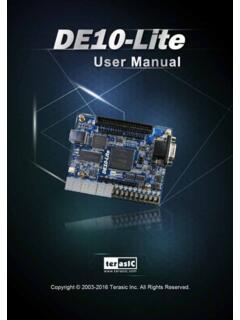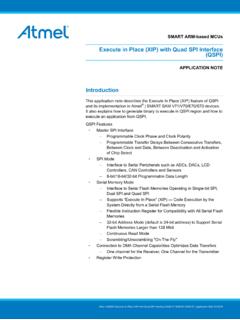Transcription of Graphical User Interfaces in Java
1 Graphical user Interfaces in Java CS314. Colorado State University GUI Components button menus menu bar combo box scroll bars A Brief History Original AWT was suitable for Java applets but not for full-fledged application development. AWT (JDK ) had better event handling but did not have enough GUI components and was too dependent on (nonportable) native code. In 1997 Netscape and Sun developed a set of GUI. classes written entirely in Java. The Java Foundation Classes (JFC), including the Swing component set, were released with JDK A Swing program can have the same look and feel on a Mac, Windows, or Unix platform. Some basic GUI. components Component Description JLabel An area where uneditable text or icons can be displayed.
2 JTextField An area in which the user inputs data from the keyboard. The area can also display information. JButton An area that triggers an event when clicked with the mouse. JCheckBox A GUI component that is either selected or not selected. JComboBox A drop-down list of items from which the user can make a selection by clicking an item in the list or possibly by typing into the box. JList An area containing a list of items from which the user can make a selection by clicking on any element in the list. Multiple elements can be selected. JPanel A container in which components can be placed and organized. Heavyweight versus Lightweight Components Heavyweight components: AWT components ( ) use native code.
3 Lightweight components: written in pure Java (more portable). Most Swing components are lightweight Exceptions: JApplet, JDialog, JFrame, and JWindow are lightweight. Developing lightweight (pure Java) components: extend and override paint(): public class LightWeightButton extends Component {. public void paint(Graphics g) {. /* Java code goes here */. }. }. Swing Hierarchy The top-level Swing windows are heavyweight. They depend on the native system. Swing classes derived from JComponent will be lightweight, written entirely in Java. Swing Hierarchy (Part II). Swing components names start with J'. AWT and Swing Swing's top-level elements -- JApplet, JDialog, JFrame, and JWindow inherit from their AWT.
4 Counterparts. The base Swing class (JComponent) is derived from Swing components are fundamentally based on the AWT. All GUI programs use classes defined in the AWT: layout managers ( ), fonts ( ), colors ( ). The Swing Component Set Swing packages *: contains Swing events and listeners; similar to *. *: contains the classes for JTextField and JTextComponent, the Swing classes that replace the AWT's TextField and TextArea classes. JLabel Label Provide text on GUI. Defined with class JLabel Can display: Single line of read-only text Image Text and image 3 import *;. 4 import *;. 5 import *;. 6. 7 public class LabelTest extends JFrame {. 8 private JLabel label1, label2, label3.}
5 9. 10 // set up GUI. 11 public LabelTest(). 12 {. 13 super( "Testing JLabel" );. 14. 15 // get content pane and set its layout 17 setLayout( new FlowLayout() );. 18. 19 // JLabel constructor with a string argument 20 label1 = new JLabel( "Label with text" );. 21 ( "This is label1" );. 22 add( label1 );. 23. 24 // JLabel constructor with string, Icon and alignment arguments 25 Icon bug = new ImageIcon(getClass().getResource( " ) );. 26 label2 = new JLabel( "Label with text and icon", bug, 27 );. 28 ( "This is label2" );. 29 add( label2 );. 31 // JLabel constructor no arguments 32 label3 = new JLabel();. 33 ( "Label with icon and text at bottom" );. 34 ( bug );. 35 ( );. 36 ( ).}
6 37 ( "This is label3" );. 38 add( label3 );. 43 } // end constructor 45 public static void main( String args[] ). 46 {. 47 LabelTest application = new LabelTest();. 48 ( );. 49 (275,170);. 50 (true);. 49 }. 50. 51 } // end class LabelTest TextFields JTextField Single-line area in which user can enter text JPasswordField Extends JTextField Hides characters that user enters // Demonstrating the JTextField class. import *;. import *;. import *;. public class TextFieldTest extends JFrame {. private JTextField textField1, textField2, textField3;. private JPasswordField passwordField;. // set up GUI. public TextFieldTest(). {. super( "Testing JTextField and JPasswordField" ).
7 SetLayout( new FlowLayout() );. // construct textfield with default sizing textField1 = new JTextField( 10 );. add( textField1 );. // construct textfield with default text textField2 = new JTextField( "Enter text here" );. add( textField2 );. // construct textfield with default text, // 20 visible elements and no event handler textField3 = new JTextField( "Uneditable text field", 20 );. ( false );. add( textField3 );. // construct passwordfield with default text passwordField = new JPasswordField( "Hidden text" );. add( passwordField );. // register event handlers TextFieldHandler handler = new TextFieldHandler();. ( handler );. ( handler );. ( handler );. ( handler ).
8 SetSize( 325, 100 );. setVisible( true );. } // end constructor TextFieldTest public static void main( String args[] ). {. TextFieldTest application = new TextFieldTest();. ( );. }. // private inner class for event handling private class TextFieldHandler implements ActionListener {. // process textfield events public void actionPerformed( ActionEvent event ). {. String string = "";. // user pressed Enter in JTextField textField1. if ( () == textField1 ). string = "textField1: " + ();. // user pressed Enter in JTextField textField2. else if ( () == textField2 ). string = "textField2: " + ();. // user pressed Enter in JTextField textField3. else if ( () == textField3 ). string = "textField3: " + ().}
9 // user pressed Enter in JTextField passwordField else if ( () == passwordField ) {. string = "passwordField: " +. new String( () );. }. ( null, string );. } // end method actionPerformed } // end private inner class TextFieldHandler } // end class TextFieldTest How Event Handling Works Two open questions How did event handler get registered? Answer: Through component's method addActionListener Lines 39-42 of How does component know to call actionPerformed? Answer: Event is dispatched only to listeners of appropriate type Each event type has corresponding event-listener interface Event ID specifies event type that occurred Event Handling Event-handling model Three parts Event source GUI component with which user interacts Event object Encapsulates information about event that occurred Event listener Receives event object when notified, then responds Programmer must perform two tasks Register event listener for event source Implement event-handling method (event handler).
10 The EventObject Class The getSource() method is used to get the Object that caused the event. Event registration for JTextField textField1. textField1 handler listenerList public void actionPerformed(. ActionEvent event ). {. // event handled here }. JTextField object TextFieldHandler object .. This reference is created by the statement ( handler );. Creating an ActionListener import *;. import *; Button click events are import *; handled by ActionListeners import *;. public class MyApplet extends JApplet implements ActionListener {. private JButton clickme = new JButton("ClickMe");. public void init() {. getContentPane().add(clickme); // Add clickme to the applet (this); // Register with a listener } // init().}


